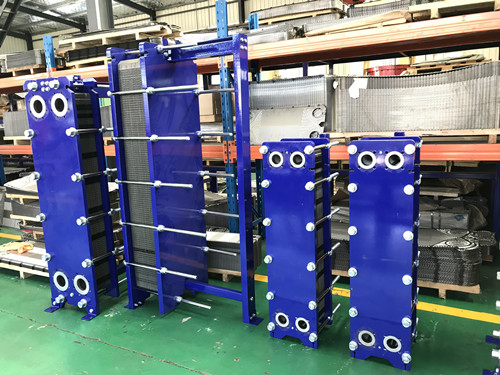An article to take you to understand the structure of pharmaceutical and chemical plate heat exchanger and heat transfer
Heat exchange equipment has the advantages of high heat transfer efficiency and easy installation. We have talked a lot about its technical knowledge before. Today we will look at the structure and heat transfer of pharmaceutical and chemical plate heat exchangers.
Plate type structure : Plate type and structure parameters have a great impact on the heat transfer of pharmaceutical and chemical plate heat exchangers. Different plate types can cause significant differences in fluid flow in the channels between the plates. Different corrugated structure parameters of the same plate type will result in different flow conditions, making it suitable for heat transfer under different operating conditions. Process combination: The uniformity of the fluid flow distribution is also reflected in the way the process is combined. For general symmetrical flow channel, when the flow of two different media is approximately equal, the process combination should also be as equal as possible;

If the difference between the two sides of the flow is large, the side with small flow can choose to use multiple processes to increase the flow and obtain a relatively high heat transfer coefficient, while the side with large flow uses fewer processes to reduce the resistance of the production equipment. Selection of flow velocity: The flow velocity between the plates affects the heat transfer performance and pressure drop of the fluid. Although the heat transfer coefficient is higher at high flow rates, the drop in fluid resistance is also greater. When the flow velocity is less than 0.2 m/s, the fluid will not reach the turbulent state and a large dead zone will be formed.
The next point is the asymmetric type: according to the heat transfer characteristics of hot and cold fluids and pressure drop requirements, the asymmetric type changes the waveform geometry on both sides of the plate, forming a hot and cold flow channel unequal flow cross-section. The asymmetric heat transfer coefficient decreases slightly and the pressure drop drops significantly. When the cold and hot medium flow is relatively large, the use of asymmetric single flow can reduce the plate area by 15%-30% compared to symmetric single flow. In recent years, China has emerged asymmetric channel, while foreign countries have adopted the "thermal mixing" plate combination mode, allowing heat, flow, pressure drop is not balanced.
Qingdao Reapter specializes in the production of pharmaceutical and chemical plate heat exchanger, with experienced technical team and staff, if you want to know Qingdao Reapter, please click below for more information. We can provide you with customized solutions, free selection and quotation!
Related information
- Which is the heating plate heat exchanger? This article gives you the answer
- Calculation method of wall temperature of heat exchanger
- Introduction to the cleaning method of Ruipute plate heat exchanger
- Principle of cleaning to prevent fouling of plate heat exchanger
- Figure out the plate heat exchanger routine maintenance precautions, so that your equipment runs efficiently
- Does heating plate heat exchangers really need to be cleaned once a year?
Relevant article
- Heat station supporting plate heat exchanger installation is a technical work, these points should be noted
- Sulfuric acid and other corrosive media for industrial plate heat exchanger requirements are what
- Simple and effective chemical cleaning method of coal chemical plate heat exchanger, can effectively improve efficiency
- A high-quality petrochemical plate heat exchanger in the production of what to consider
- These causes of chemical plate heat exchanger gasket aging you may not know
- Chemical plant plate heat exchanger, sulfuric acid cooling needs attention
- High-end plate heat exchanger customization, specifically for your special working conditions
- The working principle of gasket type industrial plate heat exchanger and the scenarios of its use are worth knowing in depth
- Still worrying about the wholesale price of industrial plate heat exchangers? An article to make you no longer tangled
- The original lubricant in the chemical plate heat exchanger plays so many roles!
Latest information
- Heat station supporting plate heat exchanger installation is a technical work, these points should be noted
- Sulfuric acid and other corrosive media for industrial plate heat exchanger requirements are what
- Simple and effective chemical cleaning method of coal chemical plate heat exchanger, can effectively improve efficiency
- A high-quality petrochemical plate heat exchanger in the production of what to consider
- These causes of chemical plate heat exchanger gasket aging you may not know
- Chemical plant plate heat exchanger, sulfuric acid cooling needs attention
- High-end plate heat exchanger customization, specifically for your special working conditions
- The working principle of gasket type industrial plate heat exchanger and the scenarios of its use are worth knowing in depth
- Still worrying about the wholesale price of industrial plate heat exchangers? An article to make you no longer tangled
- The original lubricant in the chemical plate heat exchanger plays so many roles!








